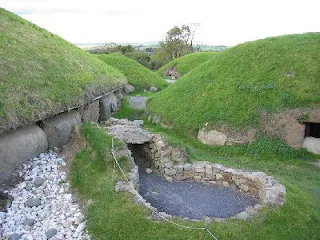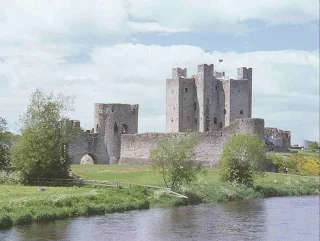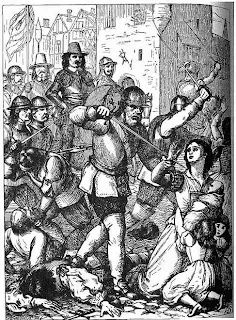Part 5 of A History of Ireland
 |
| William Smith O'Brien |
Fenians.
The origin of the Fenian movement, like the United Irishmen before it, seems unlikely today. One of its leading founders was again an Ulster Presbyterian, by the name of John Mitchell. He founded a newspaper, The United Irishman, in which he advocated a common nationality for all Irishmen, Protestant and Catholic, and openly preached republicanism and rebellion. On his arrest, the leadership of the movement was taken up by an upper-class Protestant, William Smith O’Brien who had been a Westminster MP for many years. In many ways, O’Brien was the archetypal Irish Englishman. He spoke with an English upper-class accent and had been educated at Harrow, yet he, like Hugh O’Neill, was conscious of the fact that he could trace his origins back to the ancient High Kings of Ireland. O’Brien was a descendent of Brian Boru.
In 1848, the worst year of the famine, O’Brien had a warrant out for his arrest. An attempt to execute it by a party of the Irish constabulary at Ballingary, was met with barricades and some forty people, some armed. The police retreated to a nearby house to consider their options and were followed there by the crowd. The owner, a widow named MacCormack, was out at the time but her five children were in. The police entered the house and smashed up the furniture to use as makeshift barricades and a state of siege ensued. The police fired a volley and the besiegers took cover behind walls. During the siege, more shots were fired. Two of the besiegers were killer and several more were wounded. The siege was eventually lifted, some two hours later by the arrival of more police. This was the so-called Rising of 1848. It is also known as ‘the battle of the Widow MacCormack’s cabbage garden’.
 |
| James Setephens |
... in the presence of God, to renounce all allegiance to the Queen of England, and to take up arms and fight at a moment’s warning to make Ireland an Independent Democratic Republic, and to yield implicit obedience to the commanders and superiors of this secret society...
This society was to become the Irish Republican Brotherhood. Soon after its formation, Stephens visited America where, together with John O’Mahony, he helped found the Fenian Brotherhood, named after a band of mythological Gaelic warriors. It was to be an American counterpart of the IRB, with the intention of securing material support for the IRB from embittered émigré Irish population; the 1,500,000 who had recently fled the Potato Famine. Stephens’ relationship with the Fenian Brotherhood was far from warm however, and he showed frustration at the lack of real material support in the quantities he had hoped for, with the words:
Irish tinsel patriots [with their] speeches of bayonets, gala days and jolly nights, banners and sashes, bunkum and filibustering, responding in glowing language to glowing toasts on Irish Independence over beakers of fizzing champagne
For all Stepehns’ efforts, his arrest and romantically daring escape from Richmond Jail, aided by two warders who were members of the brotherhood, the Fenian Rising was a failure. He was deposed in 1866 to be replaced by the American Civil War veteran ‘Colonel’ Kelly, with effective military command under the control of the French soldier of fortune, Cluseret. One Rising, planned for 11 February 1867, was called off at the last minute when the English authorities were ready for an attack on Chester Castle, where it was hoped a large number of arms were stored. A new Rising, planned for 5 March 1867 was averted when a self-appointed ‘General’ Massey, another American civil war veteran, was arrested the day before at Limmerick Junction, as he got off a train. He turned Queen’s evidence, and Cluseret promptly packed his bags and left for France.
 |
| The 'Manchester Martyrs' Allen, Larkin and O'Brien |
Parnell.
 |
| Charles Stewart Parnell |
Why should Ireland be treated as a geographical fragments of England...? Ireland is not a geographical fragment but a nation
In 1879 it began to become clear the Ireland was on the edge of another great famine on the scale of 1844-49. American wheat was flooding the European markets and farm prices were dropping, making it difficult for the small tenant farmers to pay rents. Additionally, disastrous weather between 1877 and 1879 had caused the potato crop to fail again. In those same years the number of evictions had quadrupled. In fact, famine was only averted by massive charitable distribution of food on a scale far larger than during the 1840s. It was this that had brought a Fenian named Michael Davitt to the realisation that what the Irish needed, in addition to political theory and nationalism, was practical help in surviving. A good year in Ireland was one in which you got through the winter without too much suffering. Davitt recruited the young MP, Parnell, to the cause of land reform. At a meeting of tenant farmers in Westport in 1879, Parnell said:
A fair rent is a rent the tenant can reasonably afford to pay according to the times, but in bad times a tenant cannot be expected to pay as much as he did in good times ... Now, what must we do in order to induce the landlord to see the position? You must show them that you intend to hold a firm grip of your homesteads and lands. You must not allow yourselves to be dispossessed as your fathers were dispossessed in 1847 ... I hope that on those properties where the rents are out of all proportion to the times a reduction may be made and that immediately. If not, you must help yourselves, and public opinion of the world will stand by you, and support you in your struggle to defend your homesteads.
 |
| Parnell's Birthplace, Avondale House, Wicklow |
- His father’s family was from the older generation of Nationalist tradition of Irish Independence, represented by the United Irishmen, which had opposed the Union. His great grandfather has been one of the Union’s strongest opponents and Parnell’s country home displayed the colours of one of the Volunteer regiments.
- His mother was American, and Americans were then closer to their own war of independence and anti-English sentiments were still strong. Her grandfather had been a famous American admiral who has taken part in the war of 1812.
So, as a rebel, with strong traditions of Republican Nationalism, and an inherited antipathy to the English, Parnell entered the Westminster parliament.
The Land League, with Parnell as its president, and with its top officials all former Fenians, now had representation at Westminster in the form of an articulate and radical MP who had no truck with the political establishment, and who, it appears, delighted in taunting the Government at Question Time. It had brought the secret agrarian societies into mainstream politics in a way that neither the United Irishmen nor the Fenians had previously managed. Davitt has identified their major political concern and had shown them a way to address it. The tenant farmer and landless agricultural labourers of Ireland, the descendants of the disposed Gaels had entered politics.
 The Land League became increasingly violent as it enforced its rules no only on landlords, but on tenants too. Though the parliamentary Party officially denounced violence, this was often done ambiguously. Joseph Biggar, MP for Cavan, for instance, condemned the shooting of landlords because ‘the assailant frequently missed and hit someone else’. Parnell was scrupulous in dissociating himself from violence in the ‘Land War’ as it became known, and he was always careful to deprecate violence. Possibly as an alternative to violence, Parnell introduced alternative methods of intimidation, which was to become known as ‘boycott’ after the land agent against whom it was first used. At an outdoor meeting at Ennis in 1880, he asked:
The Land League became increasingly violent as it enforced its rules no only on landlords, but on tenants too. Though the parliamentary Party officially denounced violence, this was often done ambiguously. Joseph Biggar, MP for Cavan, for instance, condemned the shooting of landlords because ‘the assailant frequently missed and hit someone else’. Parnell was scrupulous in dissociating himself from violence in the ‘Land War’ as it became known, and he was always careful to deprecate violence. Possibly as an alternative to violence, Parnell introduced alternative methods of intimidation, which was to become known as ‘boycott’ after the land agent against whom it was first used. At an outdoor meeting at Ennis in 1880, he asked:What do you do with a tenant who bids for a farm from which his neighbour has been evicted? Now I think I heard somebody say “Shoot him” – but I wish to point out a very much better way, a more Christian and charitable way ... You must show what you think of him on the roadside when you meet him, you must show him in the street of the town, you must show him at the shop counter ... even in the house of worship, by leaving him severely alone, by putting him into a sort of mortal Coventry, by isolating him from the rest of his kind as if he were a leper of old, you must show him your detestation of the crime he has committed.
Parnell thus brought the question of land in Ireland to the forefront of the English political scene. Prime Minister Gladstone, though broadly sympathetic to the Irish, was determined that law and order should be restored as a precondition of any reforms and introduced the Coercion Bill to bring this about. The Coercion Bill gave the police and the military special powers and suspended some civil liberties and was fought by Parnell and his followers in the House. At one point, they forced the House into a 41-Hour continuous sitting which had to be suspended by the Speaker. Parnell and thirty-five of his MPs were suspended and escorted from the House by the sergeant-at-arms.
 |
| Gladstone |
When we have undermined English misgovernment we have paved the way for Ireland to take her place amongst the nations of the earth. And let is not forget that this is the ultimate goal at which all we Irishmen aim... None of us, whether we are in America or Ireland, or wherever we may be, will be satisfied until we have destroyed the last link which keeps Ireland bound to England.
Matters were rapidly coming to a head between Parnell and Gladstone when Gladstone attacked Parnell with the following:
If there is still to be fought in Ireland a final conflict between law on the one side and sheer lawlessness on the other then I say, gentlemen, without hesitation, the resources of civilisation are not yet exhausted.
To which Parnell replied:
It is a good thing that this masquerading knight-errant, this pretending champion of the rights of every other nation except those of the Irish nation, should be obliged to throw off the mask today, and to stand revealed as the man who, by his own utterances, is prepared to carry fire and sword into your homesteads, unless you humbly abase yourselves before him and before the landlords of the country.
 |
| Recreation Time for the Land League in Kilmainham Jail |
The Land League was beginning to lose the support of the tenant farmers whom they had been trying to persuade to pay no rent at all. Parnell thus had good political and private reasons to be free from prison. He agreed to the ‘Treaty of Kilmainham’, an unwritten agreement with Gladstone to look sympathetically at the remaining problems of the tenants in return for Parnell agreeing to cool things in Ireland. I particular, Gladstone agreed to look at the question of Irish national aspirations. Parnell was released and all looks well for a new age of co-operation between the Home Rule Party and Glandstone’s Liberals.
 |
| Lord Frederick Cavendish, MP |
In the 1885 General Election, which had been fought on a wider franchise that included agricultural labourers, the Home Rule Party won eighty-six seats and held the balance between the Liberals and the Conservatives who had tied for seats. Gladstone’s response was to propose a form of internal self-government for Ireland, under which a Dublin parliament would have powers to legislate only on Irish internal matters but subject to a sovereign Westminster parliament.
Whilst Parnell supported the Bill, realising that it was probably the best on offer under the circumstances, it split the Liberals asunder. A significant faction of Gladstone’s party voted with the Conservatives who were, in Lord Randolph Churchill’s phrase, ‘playing the Orange card’. The Bill also brought the Ulster Protestants into play in opposition to it. The link between the British Conservatives and the Irish Unionists had been established. Surprisingly, it was Gladstone who was least compromising to Ulster Protestants and Parnell who sought to placate them. Parnell said:
We cannot give up a single Irishman... The class of protestants will form a most valuable element in the Irish legislature of the future, constituting, as they will, a strong minority, and exercising a moderating influence in making laws. ... The best system of government should be the resultant of whatever forces are in that country... We want all creeds and classes in Ireland.
The Ulster Protestants however continued to drill and to prepare to fight.
The Home Rule Bill was lost, due to Liberal defections, in 1886. Though this was a setback, it was not seen as more than that. The cause of Home Rule has been raised in the British parliament and a British party now has is as a cause. Parnell’s stature was greatly enhanced and was enhanced still further when two letters published by The Times in 1882, which appeared to implicate Parnell with the Phoenix Park murders of Cavendish and Burke, were proved to have been forgeries written by a Richard Piggott for money. Parnell had actually received a standing ovation when he next entered the House of Commons.
William O’Shea has been playing a waiting game. At first, he had even encouraged the liaison between his wife and Parnell, but when Katherine’s rich aunt eventually dies and left her a considerable fortune, he sued for divorce – and his share of the fortune. He had realised that, had Katherine’s aunt got a whiff of sexual scandal, she would have changed her will to exclude her. The effect of the ensuing scandal on Catholic Ireland, and on non-conformist England (the power-base of the Liberal Party) was immediate. Parnell the adulterer became the butt of music-hall jokes and the laughing-stock of the Press.
In December 1890, in Committee Room 15 at the House of Commons, Parnell was replaced as party leader by 45 votes to 29. The party split into Parnellite and anti-Parnell factions and the Home Rule question became subordinate to the question of whether an adulterer could be allowed to lead the Irish nation’s party. Parnell tried to cling to power and succeeded only in alienating the Church and the people. He lost three by-elections in a row, just a year after he had been uncrowned King of Ireland. His health deteriorated and he died on 6 October 1891. Maybe the hope of a peaceful transition to Home Rule and Irish independence died with him.



























